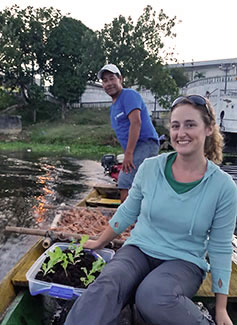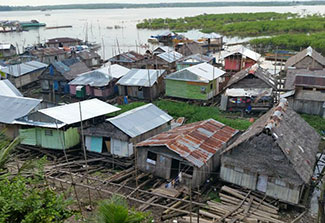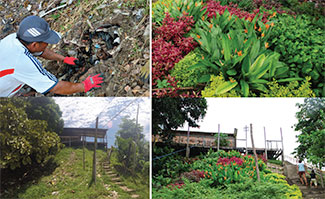
Profile: Fogarty Fellow Dr Leann Andrews studies how establishing gardens in a Peru slum can improve health
July / August 2019 | Volume 18, Number 4

All photos courtesy of Dr. Leann Andrews
By Shana Potash
For Dr. Leann Andrews, a Fogarty fellowship gave her the opportunity to pilot a program and watch it grow - literally. As the first landscape architect in the Global Health Program for Fellows and Scholars, she launched a project to establish gardens to improve health in a slum community in Iquitos, Peru.
Andrews worked in a neighborhood called Claverito located in the Amazon River floodplain. The roughly 280 residents, families that migrated from the jungle to the city, live in a collection of 50 homes built on large logs, so the structures float during the months the river is high, then rest on the ground the remainder of the year. Because Claverito is an informal settlement that is not recognized by the government, residents do not have access to electricity, clean water and other municipal services.
The research team consisted of specialists from the University of Washington and universities in Peru, along with local experts, and represented 17 disciplines, including doctors, nurses, biologists, anthropologists and landscape architects. Using a One Health approach, they surveyed the health of Claverito’s adults and children, as well as the flora and fauna, before and after the landscape intervention.
The study used community-participatory design techniques that included residents throughout the process. They helped design and build a garden at the community entrance, filling it with plants for food, medicine, beautification and habitat. Foliage that acts as a water filtration system was planted and new concrete stairs with handrails were installed to replace unsafe wood and mud steps. And customized, individual gardens were created for the 28 households in the study.
Working with families at their kitchen tables to plan their gardens, Andrews said she was struck by the fact that everyone chose at least one plant solely for aesthetics. “It shows the intuitive understanding that beauty is part of your life and it does improve your quality of life.”

Homes in Claverito, which is located in the Amazon River flood
plain, are built on logs to float during the high river season.
plain, are built on logs to float during the high river season.

A community garden was built at the entrance to Claverito and
wood and mud steps were replaced with safer concrete stairs
with handrails.
wood and mud steps were replaced with safer concrete stairs
with handrails.
Among the findings from the first year of the project, the percentage of families with moderate to severe food insecurity dropped from 89% to 56%, and people reporting mild to severe depressive symptoms decreased from 70% to 44%. Aquatic vegetation reduced e. coli in the water and there was far less trash at the community’s entrance, which had provided a breeding ground for disease-carrying mosquitoes. Additionally, 13 new species of birds and 11 new species of butterflies were recorded.
Because health research is not common in landscape architecture, the fellowship gave Andrews entrée into clinical research, and provided her with the baseline skills needed to design studies and collect and analyze data. She also gained experience leading a transdisciplinary team and solving problems, like building gardens in a city that, unlike those in the U.S., doesn’t have nurseries where you can simply order soil and plants.
“We had to find someone who would harvest seeds from the jungle and help us grow our plants,” she said, “Or the wood, you don’t just get a 2-by-4, you get a tree and cut it to the dimensions you want.”
The fellowship enabled Andrews and her Peruvian colleague and Fogarty Fellow alumnus Coco Alarcón to jumpstart a long-term design, research and training program. Now in its third year, their InterACTION Labs program has expanded the research in Claverito to design parks, gardens, and a community center and has provided training for about 95 faculty and students from partner institutions in Peru and the U.S.
“The Fogarty program was really my ticket,” Andrews said. She is exploring opportunities for other NIH-funded research and training and looking for people to join her in the field of global health landscape architecture.
“When you hear the stories, when you see kids playing on the things you’ve built, when you see butterflies land on the flowers, those are things that really help you understand the work you do is meaningful and valued,” she said.
More Information
- Dr. Leann Andrews from University of Washington
- Penn State Landscape Architecture program adds new tenure-line faculty , including Leann Andrews
Penn State news, August 13, 2019
To view Adobe PDF files, download current, free accessible plug-ins from Adobe's website .





















.png)









No hay comentarios:
Publicar un comentario